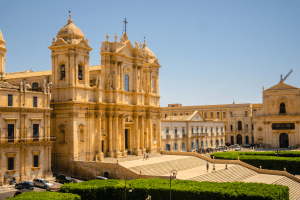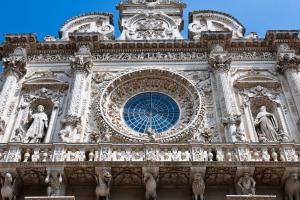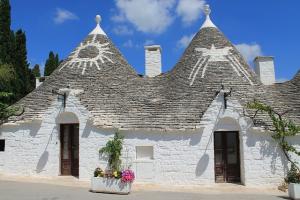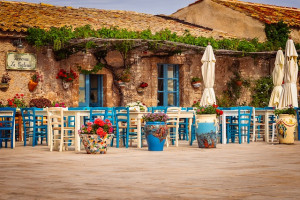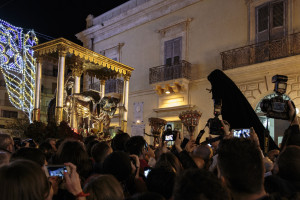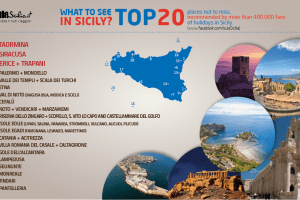- City of Trapani
City of Trapani

The city of Trapani has about 70 350 inhabitants, it’s the capital of the province and includes 24 municipalities. Known as the "city of the two sea“, Trapani enjoys a privileged location on the western tip of Sicily, between the Tyrrhenian Sea and the Strait of Sicily, under the promontory of Mount Erice.
The vast territory of Trapani includes everything that can be used to propose an offer for a qualified tour. The city, in addition to its well-equipped port, docking station for trips to the Egadi Islands (Favignana, Levanzo and Marettimo), Pantelleria, Mothya, is also home to the airport Birgi "Vincenzo Florio”. The presence of these two strategic structures promote numerous flows of travelers who can enjoy the many resources in the area: beaches, nature reserves (Riserva delle Saline di Trapani e Paceco, Riserva dello Zingaro, Riserva dello Stagnone di Marsala), archaeological sites and tasty culinary traditions.
THE MAIN MONUMENTS: Trapani is presented to visitors with a modern part and an old part, which is the historic center. The new part runs from Corso Piersanti Mattarella, up to Via Conte Agostino Pepoli. The boundary between the new town and the old one is the Piazza Vittorio Emanuele. The historic center of Trapani winds, however, along the main streets of Corso Vittorio Emanuele, the ancient Loggia, Via Torrearsa and Via Garibaldi. It’s home to historic buildings, ancient monuments, churches and museums. Among the historic buildings to remember Palazzo Cavarretta, Palazzo Riccio di Morana, Palazzo San Rocco, Palazzo Riccio St. Joachim, Palace Lucatelli. Between the churches and monuments, significant are the College Church, the Church of Purgatory, the Church of San Domenico, the Church of St. Augustine, located near the Piazza with the same name, the former Church of St. James, the present headquarters of the Library Fardelliana, the St. Peter's Church, the Cathedral of San Lorenzo, the Basilica of Our Lady of Trapani. Among the museums, the city is home to the Regional Museum of Pepoli, located next to the Shrine of the Annunciation, and the Museum of Prehistory and Sea, located at the Tower of Ligny dating back to 1791. Finally, in the north of the city lies the picturesque coast with the famous Piazza del Mercato del Pesce. A mention deserves the five towers of Trapani, built to defend the city and built during the Phoenician colonization. Castle Tower of Earth, located in Piazza Vittorio Veneto, the present headquarters of the Palace of the Police; Peliade Tower (Castle of the Sea or Dovecote), opposite the Castle of the Earth, which was built on the small island; Torre Pali, for whose testimony there is nothing left; Old Tower, located in Via delle Arti, where now stands the palace the Inspectorate of Finance (former monastery of Badia Nuova); Dark Tower, of which there are reliable sources but hypotheses that identify it as the modern Torre dell'Orologio or like the “Torre di Porta Scura” .
HISTORY: Trapani is derived from the Greek "Drepanum" which means, "sickle" and is linked to the unique curved shape of its port, similar in fact to this tool. The foundation of the city took place in the ninth century by the Phoenicians, who arrived there from Carthage moving toward the western coast of Sicily. During the colonization of the Greeks in Sicily, in the eighth century BC, Trapani came under the control of Carthage, which made the city an important commercial port. The famous Battle of the Egadi handed Trapani to the Roman domination of Catullus. After the Romans, the city was dominated by the Vandals, Byzantines. In the ninth century AD, the Arab domination increased the development of agricultural activities. In 1077, under the Normans led by Roger I of Sicily, Trapani became one of the major shopping centers. The climax of this development occurred in 1270 when King Charles of Anjou arrived in Trapani during the Eighth Crusade. In 1282 Peter III of Aragon began the conquest of the island. In 1535 Trapani came under Spanish rule of Emperor Charles V, who strengthened the fortifications, and contributed to a further increase in the business activities and crafts. The Spanish rule ended in 1713. The second half of the eighteenth century until 1860, saw the advent of the Bourbon Kingdom with the Kingdom of the Two Sicilies. Trapani became a flourishing trade and industry city. The 900 are remembered for the tragic earthquake of Belice Valley (1968), now known as one of the most violent earthquakes ever occurred in Sicily.
